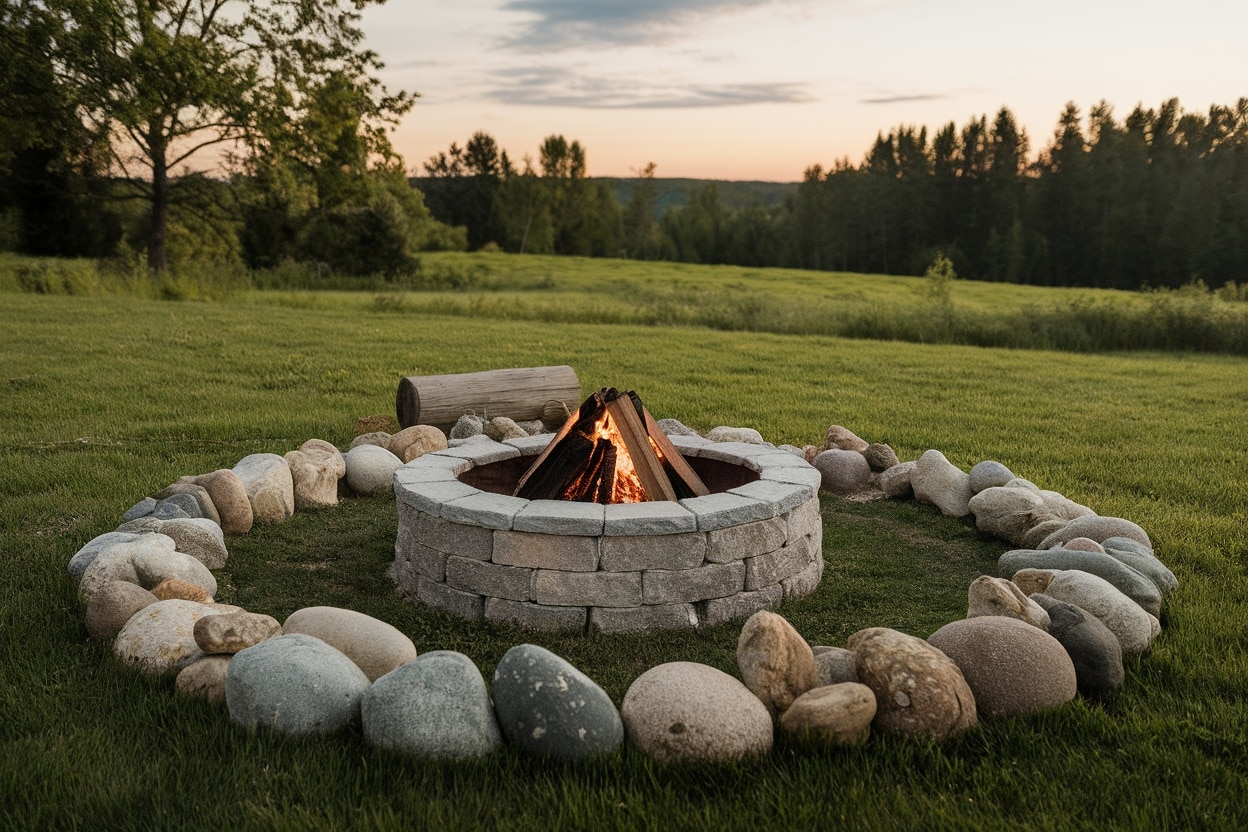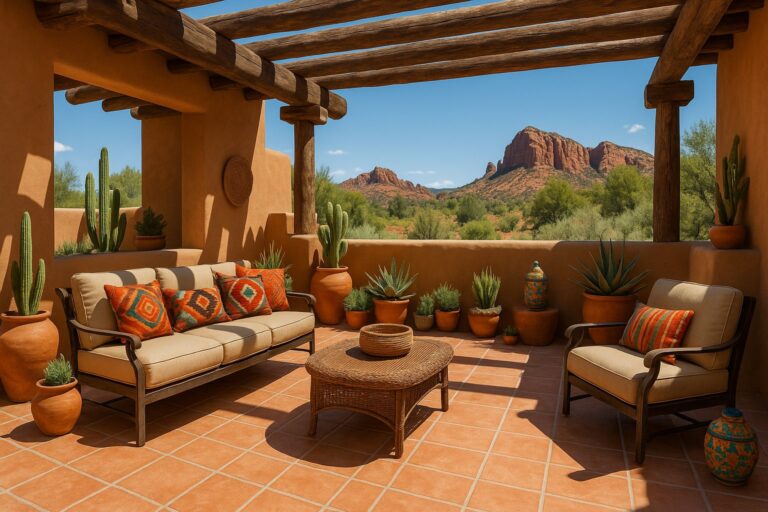12 Fire Pit Designs to Create the Ultimate Outdoor Gathering Space for Year-Round Entertainment
Fire pits draw people in. They turn plain backyards into cozy, inviting spots that just beg for a gathering.
You get warmth, a little magic, and a reason for everyone to linger outside—no matter the season.
Pick the right fire pit and suddenly your outdoor space is both more functional and way better looking. Some folks want modern fire pit designs, others chase a rustic vibe.
You’ll find everything from permanent, built-in pits with matching seating to lightweight, portable options you can move around. Stone, steel, brick, and concrete all have their perks, so you can match your style and budget.
Add-ons like built-in grills or custom seating push these fire pits beyond “just a place to burn wood.” Suddenly, it’s the heart of your backyard.
Sunken Fire Pit with Built-In Seating
Sunken fire pits with built-in seating make it easy for people to gather close. The recessed layout means you don’t have to drag out chairs, and the area feels defined.
Stone benches or built-in seats stick around through any weather and don’t need much upkeep. Designers usually keep the height and depth consistent so you can sit comfortably for hours.
Circular or square layouts encourage people to actually talk to each other. Stone benches that spill into flower beds tie the whole space together.
You can build these seats out of natural stone, concrete blocks, or brick to match your pit. Toss on some cushions or pillows if you want extra comfort.
That sunken design keeps the heat in and makes the space feel even cozier. Guests end up closer to the fire and to each other—way more connected than with a regular setup.
Built-in seating means you don’t have to store furniture, and the yard stays tidy all year. Plus, a permanent fire pit like this can bump up your property value.
Circular Stone Fire Pit with Flagstone Surround
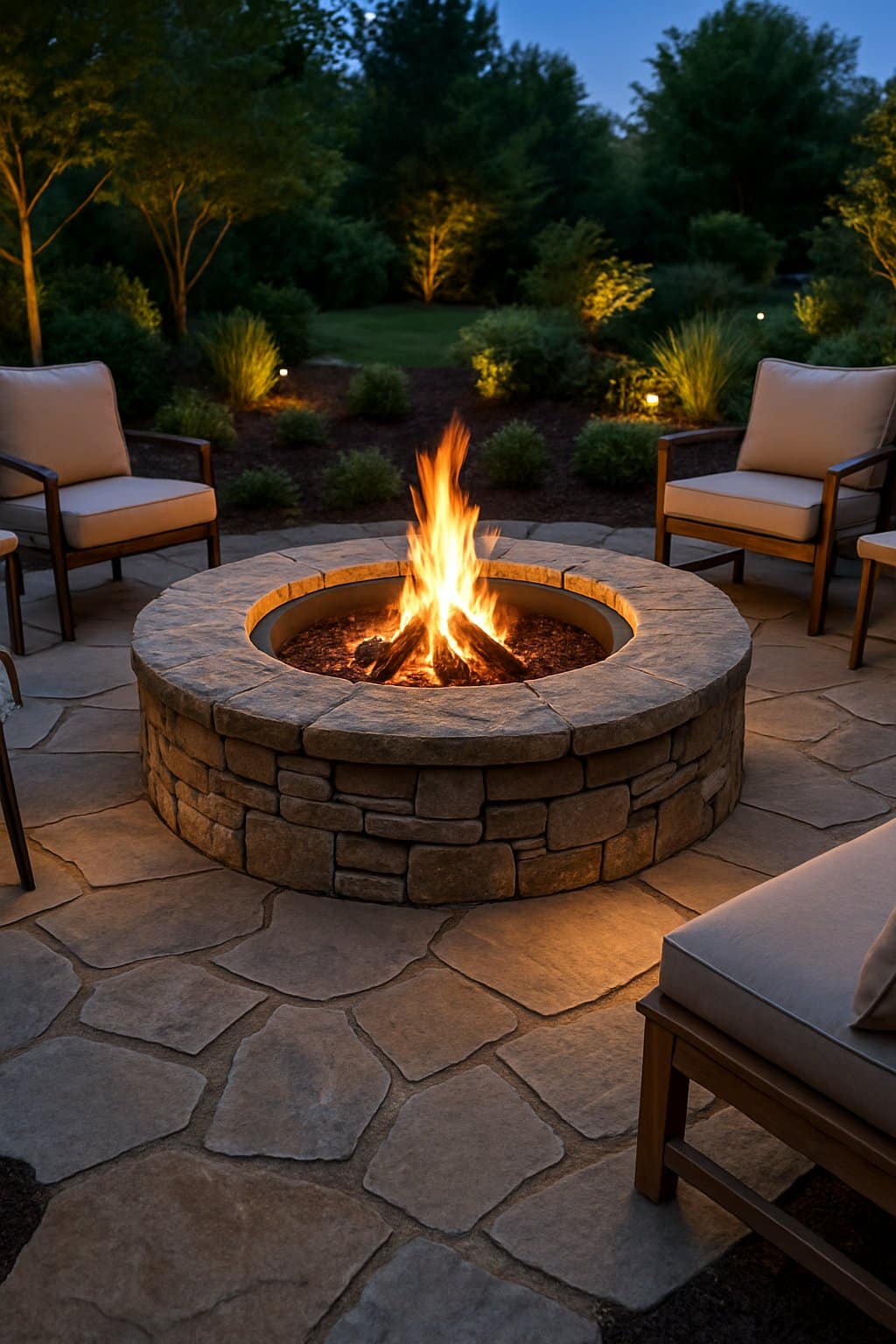
A circular stone fire pit instantly becomes the centerpiece, pulling everyone in. The shape just feels right for conversation and lets everyone get close to the flames.
Flagstone works great as a surround because it’s tough and shrugs off heat. It also looks gorgeous and never really goes out of style.
The funky shapes and textures of flagstone keep things interesting. You can lay them out in a random pattern or go for a more organized look if that’s your thing.
You’ll need a solid base and good drainage under the flagstone. Extending the stones out three feet from the fire edge gives everyone enough room to sit safely.
Flagstone comes in all sorts of colors—gray, tan, rust, blue. It usually blends right in with whatever you’ve got growing in the yard.
Flagstone patios with fire pits look sharp and work hard. You get a little rustic charm, a little modern flair, and a perfect spot to hang out.
Modern Steel Fire Bowl
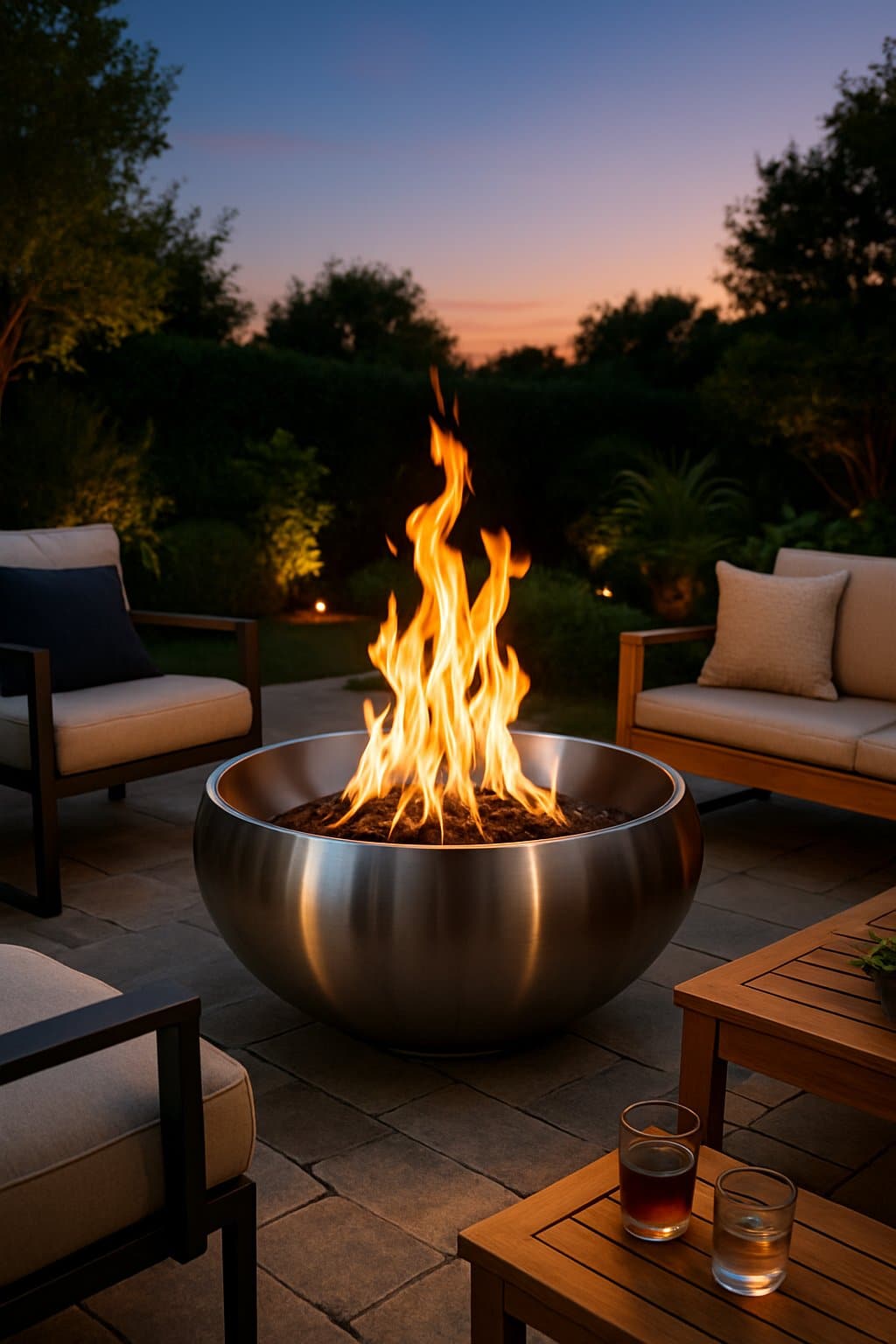
A modern steel fire bowl just oozes cool. The clean lines and simple style fit right in with contemporary landscaping.
Steel bowls are tough and hold heat well. Over time, they develop a patina that gives them even more character.
Shallow steel bowls on metal stands look striking, especially in a minimalist setting. The hand-sanded finish lets them rust in a unique way.
You can put these bowls anywhere—by the pool, in the garden, wherever you want a focal point. The raised design gives everyone a good view of the flames.
Maintenance is low-key. Just clean it now and then, maybe treat the rust if you care about that sort of thing.
Steel’s neutral look means it plays nice with pretty much any color scheme. You can switch up your outdoor decor and the bowl will always fit in.
Some models come with extras like spark screens or grill grates. Handy if you want to roast a marshmallow or keep things safe.
DIY Brick Fire Pit
Build a brick fire pit and you’ve got a backyard hangout spot in a weekend. This DIY project only calls for stuff you’ll find at the hardware store.
Fire bricks handle the heat inside, while regular bricks make up the outside. A metal ring adds safety and keeps everything in place.
Go with the classic round look. Stack those bricks up to about knee-height and you’re good.
Don’t skip the drainage—gravel in the base stops water from pooling and keeps the pit solid. It’s one of those steps you’ll be glad you didn’t rush.
Simple plans mean you don’t need to mess with gas lines. Toss in some wood, and you get real crackle and smoke.
Give yourself at least 10 feet from any buildings, just to be safe. Check local codes before you start, or you might have to redo things.
Once you’re done, you’ve got a fire pit that draws everyone outside, season after season.
Gas-Powered Fire Table
Gas fire tables bring together the best of both worlds—a fire pit and a table for snacks or drinks. These pieces make outdoor spaces more useful without eating up extra room.
You’ll find gas fire tables in all shapes and sizes, so it’s not hard to match your patio. They really shine in small spaces.
Most run on propane and start with the push of a button. No wood, no mess, no cleanup.
Top-notch fire tables use stainless steel or brass burners for even flames and long-lasting performance.
The tabletop around the flame gives you a spot for drinks, plates, or even a little decor. It’s perfect for hosting friends and still keeping that cozy fire vibe.
Hookups are simple—a propane tank or a natural gas line. Propane’s nice if you want to move the table around.
You’ll find these tables become natural hangout spots for relaxing or chatting.
Rustic Fire Pit with Reclaimed Wood Seating
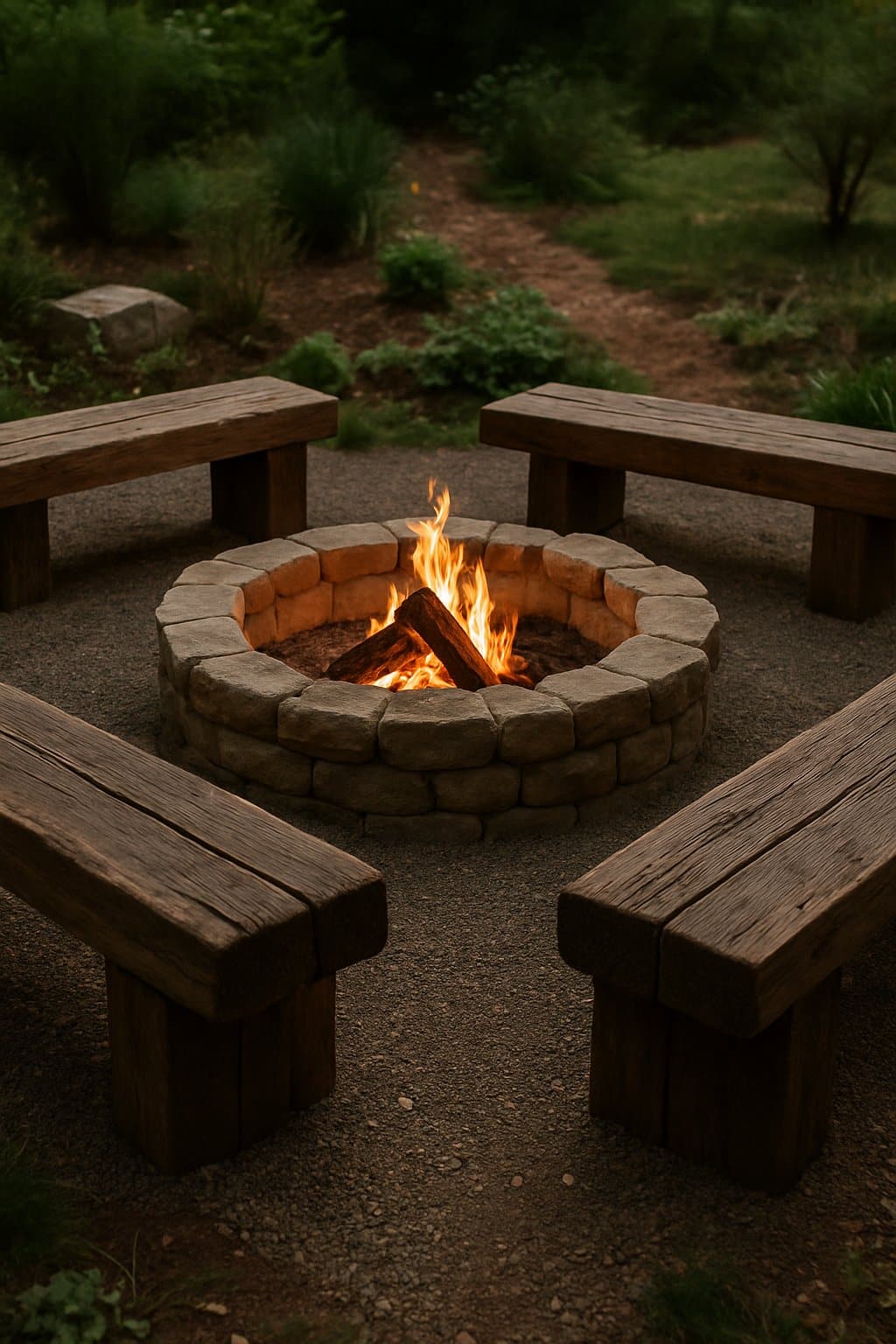
Reclaimed wood benches give fire pit areas a homey, lived-in feel. The old wood brings texture and character that’s tough to fake.
Reclaimed seating works well for big groups and keeps things tidy. It just fits with stone or metal fire pits.
You can curve the benches around the pit or line them up straight—whatever works with your space. This flexibility makes it easy to fit everyone in.
If you treat the wood, it’ll hold up through rain, snow, and sun. Over time, the weather just adds more charm.
Keep the benches 16-18 inches tall for comfort. The wood tones fit right in with rustic landscaping and plants.
Maintenance is pretty minimal. Clean them up now and then, maybe reseal if you want.
Mixing natural stone pits with reclaimed benches creates a spot that’s both practical and genuinely inviting.
Portable Copper Fire Pit Bowl
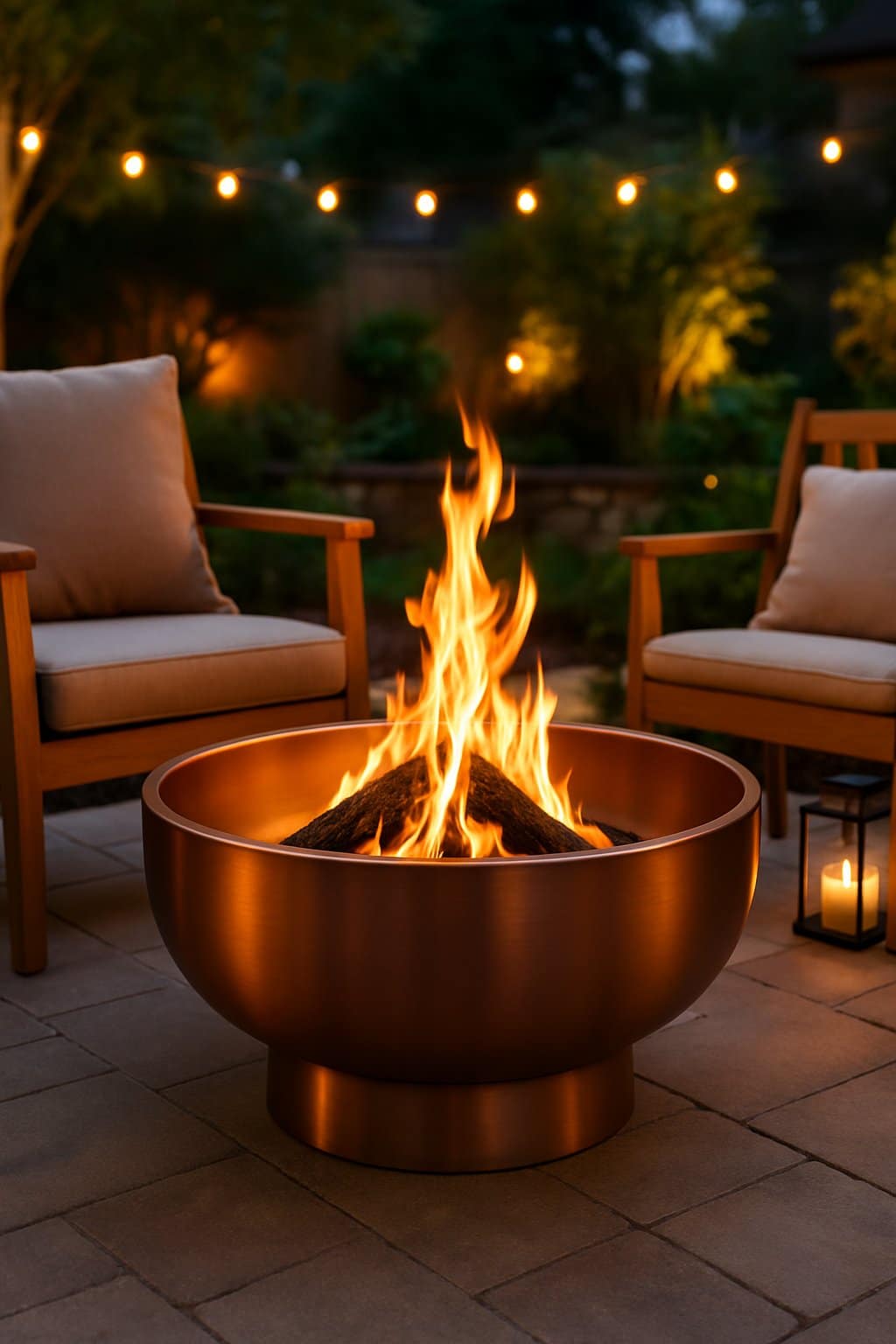
Portable fire pit bowls make it easy to take the party wherever you want. Move them from the patio to the campsite—no sweat.
Copper bowls heat evenly and pick up a cool patina as they age. That weathered look is a big part of the appeal.
Most copper bowls are light enough to carry, and some fold up or come apart for storage.
The bowl shape keeps the fire contained and throws heat in all directions. Everyone gets a good spot.
Sizes usually run from about 26 to 32 inches across. Go smaller for date night, bigger for a crowd.
Lots of models come with screens, covers, or pokers. Handy for keeping sparks in check and extending the life of the pit.
Setup is a breeze. Find a safe spot, set it down, and light it up.
Hand-hammered copper versions show off unique textures and patterns. No two are exactly the same.
Fire Pit Bench Combo
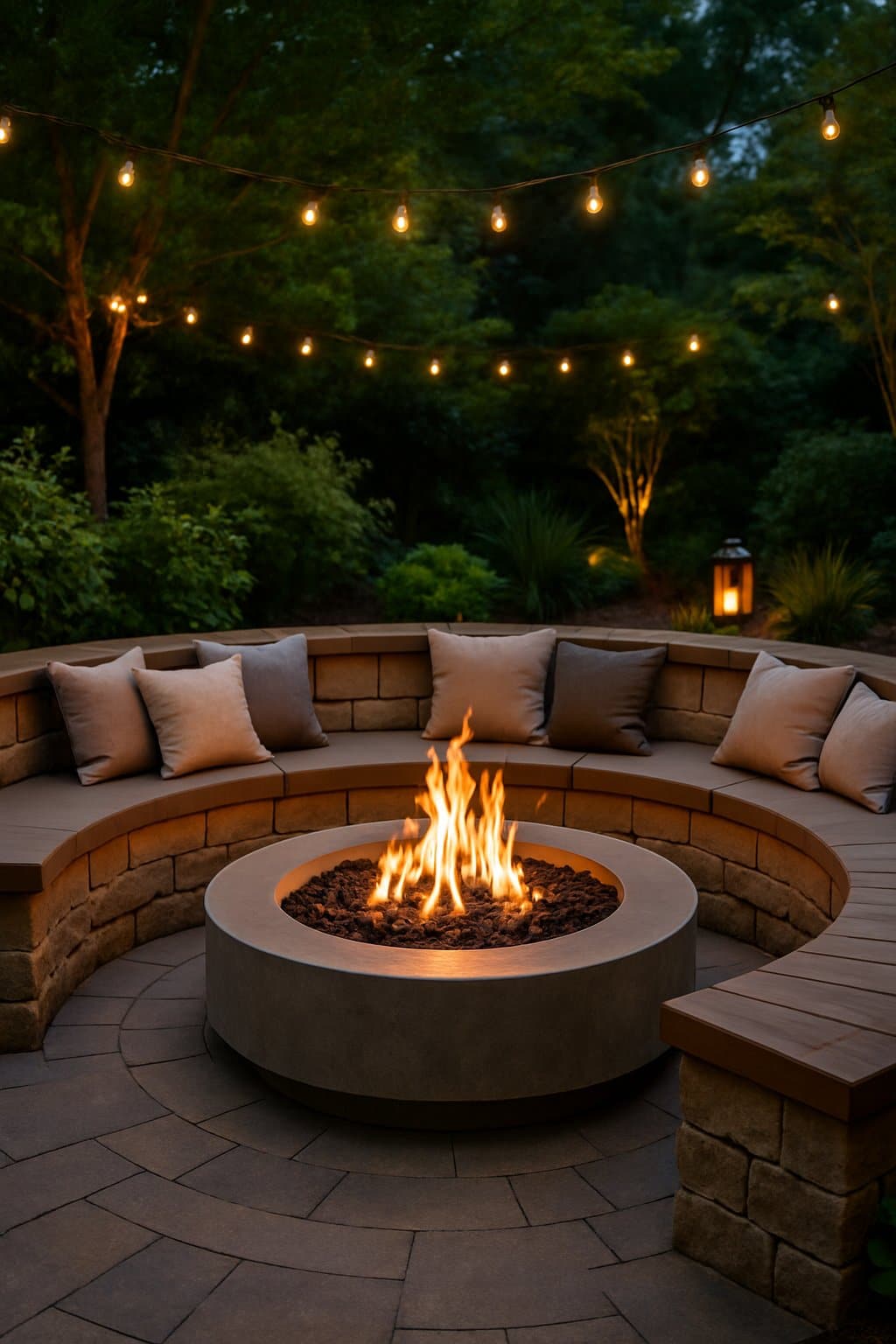
Fire pits with built-in benches tie everything together. You don’t have to worry about dragging out chairs or finding extra seats.
Benches usually wrap halfway or all the way around the pit. Stone and concrete are favorites since they last and handle the heat.
The fire pit bench combo keeps things simple—no extra furniture to stash when winter hits.
Just make sure the benches are far enough from the flames. You don’t want anyone roasting more than marshmallows.
Stone benches in a semi-circle balance the look and give everyone a spot to sit.
Building usually means pouring a solid footing so nothing shifts. Aim for bench heights of 16-18 inches so folks actually want to sit down.
These combos are perfect for smaller yards where every inch counts. They create a permanent hangout that’s always ready for guests.
Sunken Fire Pit with Fire Glass

Fire glass turns sunken fire pits into eye-catching focal points, scattering and reflecting light in all sorts of interesting ways. You can pick from a bunch of tempered glass colors and sizes, so matching your vibe is pretty easy.
Gas-powered systems are the only way to go with fire glass—wood just doesn’t work here. Just pile the glass over the burner, and suddenly the flames seem to leap right out of those colorful bits.
If you’re installing one, you’ll need to hook up a gas line and make sure the sunken area drains well. The glass should cover the burner, but you still want gas to flow easily through the pieces.
Cleaning is simple: just wash the glass with mild soap and water now and then to keep it sparkling. Weather and rain will dull the shine eventually, but it doesn’t take much effort to get it looking fresh again.
Since fire glass doesn’t make smoke or ash, it’s perfect for cozy outdoor gathering spots in neighborhoods. That means no more sweeping up after a wood fire.
You can go wild with color—clear, blue, amber, green, bronze, and more. Mixing a couple shades together? That always looks cool and ties the whole landscape together.
Even when the fire pit is off, the glass reflects light and adds some flair during the day.
Concrete Ring Fire Pit
Concrete rings make fire pit building feel almost too easy. Stack these pre-cast circles and you’ve got instant structure and height.
Most people can tackle a concrete rings fire pit project in a single afternoon—no fancy tools needed, just basic supplies.
Rings usually come in 36 to 48-inch diameters. Some folks add adhesive between layers for extra hold, but you can skip it if you want to rearrange things later.
Thick concrete holds in heat and blocks wind, so fires burn steady. The walls spread warmth evenly and shield the flames from gusts.
Start by leveling the ground and laying a solid base. Sand or gravel underneath keeps water draining and stops the pit from shifting.
Want a taller pit? Just stack on another ring. Two rings is the classic 24-inch height, but three works for bigger fires.
Concrete rings handle temperature swings better than poured concrete. Since they’re all the same thickness, you won’t get those weird cracks that pop up in custom jobs.
The clean, round look fits right in whether your yard is rustic or modern. It doesn’t take over the space, but it always feels intentional.
Fire Pit with Built-In Grill
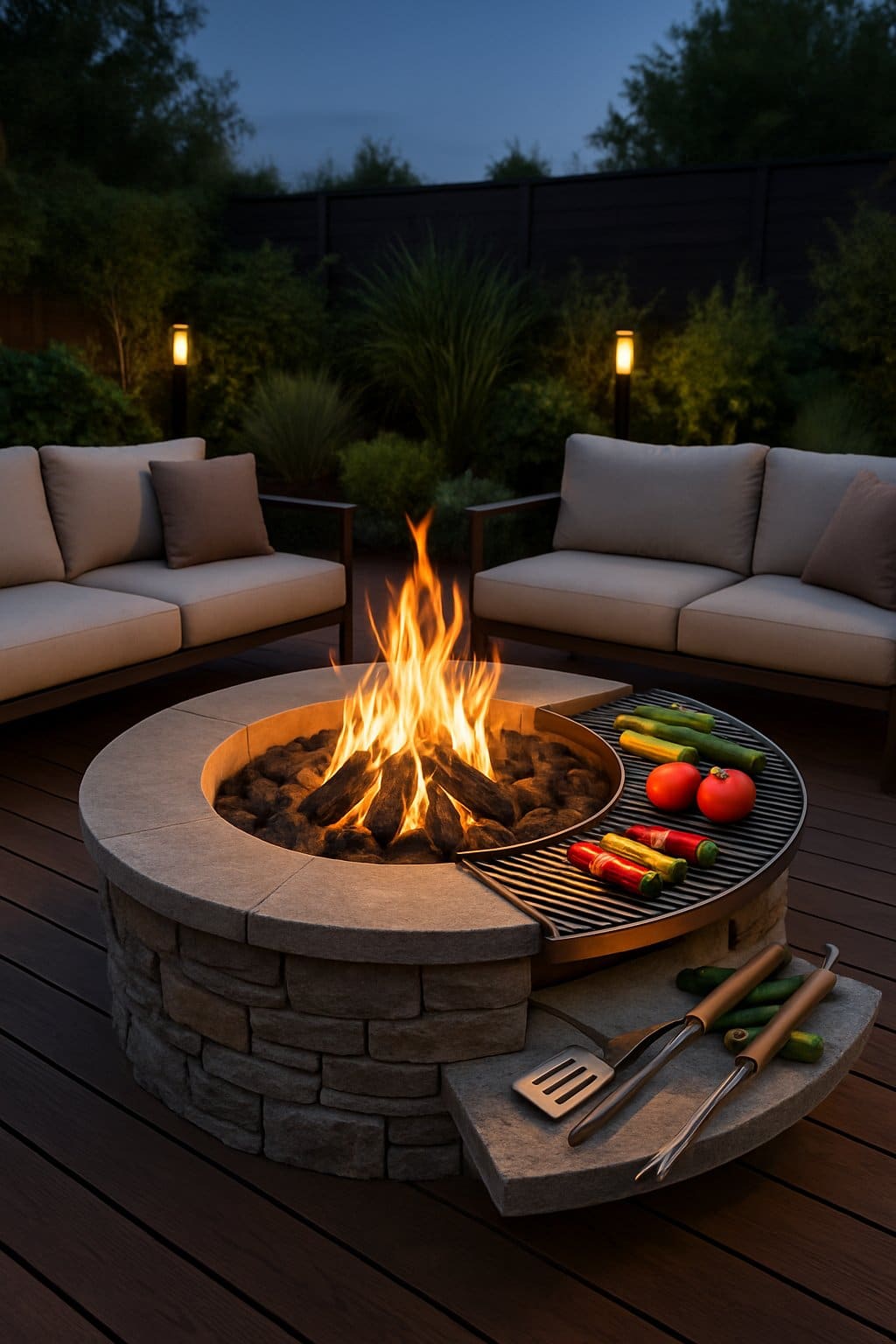
A fire pit with a built-in grill brings heat and cooking together—no need for a separate barbecue. It really simplifies things for backyard gatherings.
Stone is a great pick for fire pit grill combinations. Not only does it handle the heat, but it looks rugged and inviting.
Most of these pits come with adjustable grates. You can move them up or down to nail the right temperature for whatever’s on the menu.
Charcoal adds that smoky flavor you just can’t get from gas. If you love old-school barbecue, you’ll appreciate the difference.
Set up some weathered outdoor chairs around it and you’ve got a perfect spot for friends to hang out while dinner sizzles.
You’ll need to keep enough space between the pit and any buildings—local fire codes can be strict about placement.
Just remember to clean out ash and keep the grate tidy. It keeps everything working smoothly and safely.
Fire Pit Surrounded by Adirondack Chairs
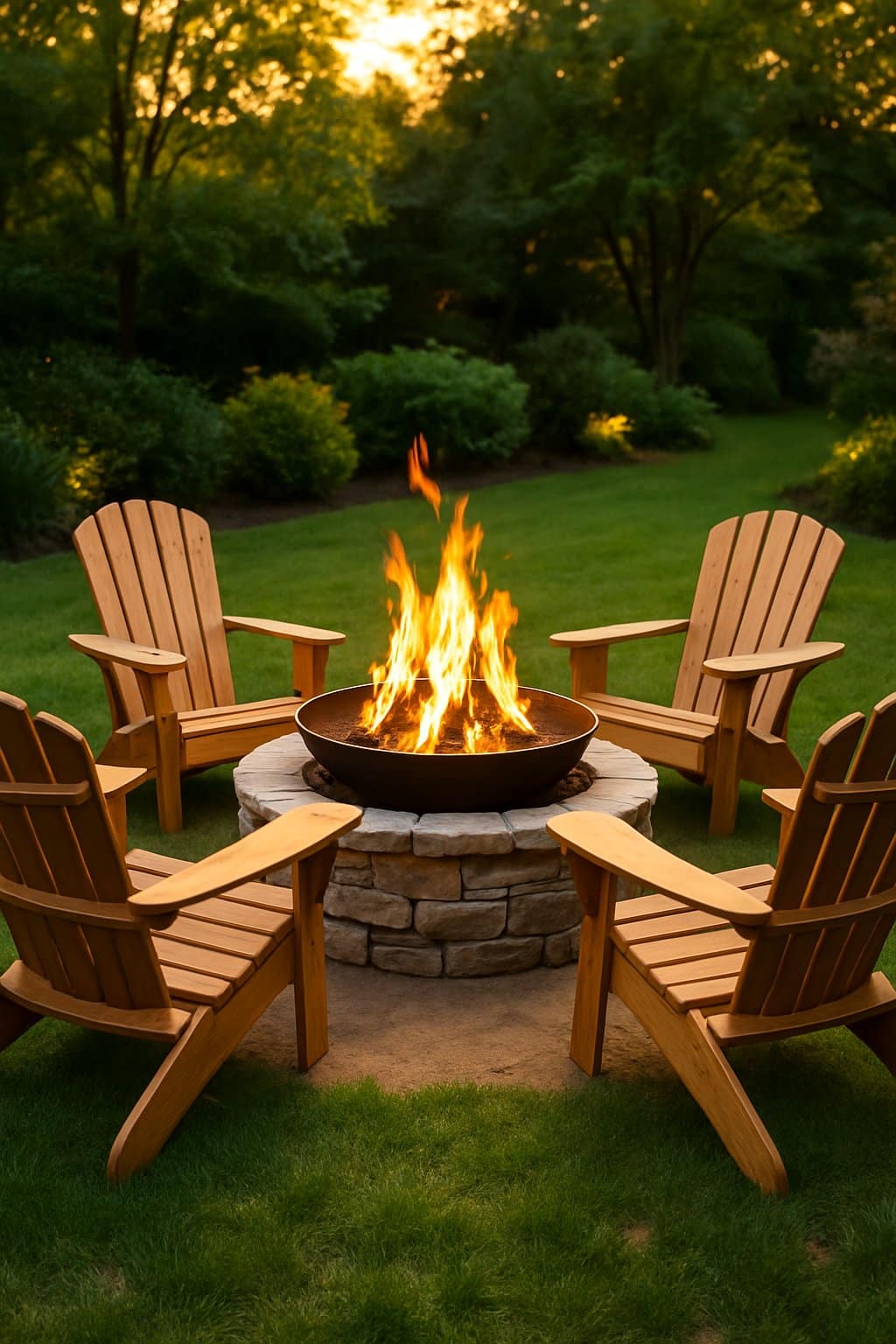
Classic Adirondack chairs add charm and comfort to any fire pit setup. Their angled backs make them surprisingly comfy for long evenings outside.
Usually, people arrange the chairs in a circle around the pit. It’s a simple move, but it does wonders for conversation and togetherness.
Adirondack chairs pair nicely with circular stone fire pits. The natural vibes mesh with almost any landscaping style.
Give each chair enough space for legs and safety, but keep the circle tight enough for a social feel.
Wide armrests on these chairs are perfect for balancing drinks or plates. It’s a little thing, but it makes a big difference when you’re relaxing.
Black Adirondack chairs pop against lighter stone pits. If you like color, you can find plenty of fun finishes to match your style.
Well-made Adirondack chairs hold up to the weather, so you can leave them out all year. That makes them a smart pick for fire pit zones.
Enhancing Ambiance and Functionality
Furniture, lighting, and a few seasonal touches can totally change a basic fire pit into a backyard hangout you’ll actually use. Where you put the seats and how you light things up makes a bigger difference than you might think.
Choosing Complementary Outdoor Furniture
Seating arrangement really sets the tone for a fire pit area. Try to keep chairs and benches about 6-8 feet from the fire so it’s warm but not overwhelming. Nobody wants to roast their shins.
Built-in stone benches stick around year-round and look great next to a stone pit. No storage hassles, either. Throw on some weatherproof cushions for extra comfort.
Modular outdoor furniture is a lifesaver for changing group sizes. Sectionals can be moved around to fit however many people show up. Teak, aluminum, or all-weather wicker are solid choices that won’t fall apart in the rain.
Side tables are a must for snacks and drinks—just pick ones that won’t tip over if the wind picks up.
Don’t forget about how people move around the fire pit. Leave 3-4 feet behind the chairs for a walkway. It’s just enough so folks aren’t tripping over each other or getting too close to the flames.
Integrating Lighting for Evening Gatherings
Layered lighting keeps the party going after dark. Use a mix of ambient, task, and accent lights so the fire stays the star but you can still see your drink.
String lights hung 8-10 feet up give off a gentle glow. LED types are energy savers and don’t get hot. Warm white bulbs (2700K-3000K) blend nicely with firelight.
Path lighting helps everyone get around safely. Line walkways with solar or low-voltage LED lights every 6-8 feet. Nobody likes stumbling in the dark.
Lanterns and portable lights are handy for switching up the mood. Battery-powered lanterns go anywhere—on tables, hanging from hooks, wherever you want a little more light. Adjustable outdoor ambiance is easy with these.
Uplighting can make trees or garden features pop. A few well-placed lights at the base of a tree or wall add depth and interest beyond the fire pit itself.
Seasonal Additions for Year-Round Use
Winter accessories help you enjoy the fire pit even when it’s chilly. Weather-resistant blankets are a lifesaver on cold nights. Store them in waterproof ottomans that double as extra seats.
Fire-resistant outdoor rugs make things feel cozy and keep toes warm. Go for synthetic materials—they handle moisture and won’t fade as fast. Make sure the rug is big enough to cover the area around your furniture.
In spring and summer, shade matters more. Umbrellas or pergolas block midday sun but still let you enjoy the open air. Retractable options are great for unpredictable weather.
Outdoor heaters can back up the fire pit when it’s not quite cold enough for a full blaze. Mount them on a pergola or use portable heaters around the edge of the seating area.
Storage benches keep all the extras neat and ready. Look for weatherproof versions with hydraulic lids—they’re great for cushions, blankets, and whatever else you want handy. Enhanced outdoor functionality comes down to little details like this.
Wind screens made of glass or metal block gusts without trapping heat. Portable ones let you adjust for the weather, which is honestly super helpful.
Fire Pit Safety and Maintenance
Staying safe and keeping things clean go a long way toward making your fire pit last. Where you place it and what it’s made of can make or break the experience.
Materials and Placement Considerations
Give fire pits plenty of space from houses, trees, and anything flammable. Most codes ask for at least 10 feet, but some places want 25 feet or more.
Steel fire pits heat up fast and cool off quickly, which is great for patios or gravel spots. Stone or brick fire pits hold heat longer and blend in with landscaping, but they need a solid base.
Make sure the ground is level before you set up. Gravel or sand under portable pits stops grass fires and helps with drainage.
Wind direction matters more than you’d think. Place the pit so smoke blows away from seats and neighbors, and avoid spots where smoke can just hang around.
Keep a fire extinguisher, hose, or bucket of sand within 25 feet—some places actually require it. Safety measures for outdoor fire pits aren’t just a suggestion; they’re often the law.
Routine Cleaning and Upkeep Tips
After each use, let the fire pit cool off completely, then scoop out the ash and debris. If you let ash pile up, it really messes with airflow and leads to annoying, uneven burning.
Toss the ash into a metal container with a tight lid. Anything else is just asking for trouble.
Monthly maintenance tasks:
- Grab a wire brush and scrub the fire bowl.
- Check those gas connections if you’ve got a propane model.
- Look over the screens for holes or any kind of damage.
- Make sure drainage holes aren’t blocked up.
Steel fire pits, especially in humid places, just love to rust. Every year, slap on some high-temperature paint to fight off corrosion.
Before you paint, sand down any rusty spots so the paint actually sticks.
If you’ve got a stone fire pit, check the joints for cracks in the mortar. Water sneaks in during those freeze-thaw cycles and can do a number on the structure.
Seal natural stone every couple of years so it doesn’t soak up water like a sponge.
For gas fire pits, take a look at the propane tank connections every few months. Mix up a little soap and water—if you see bubbles, you’ve got a leak.
Don’t mess around with damaged hoses or fittings—swap them out right away to avoid any risky gas buildup.

